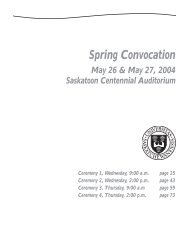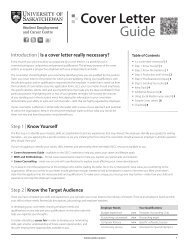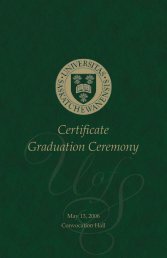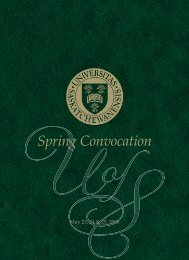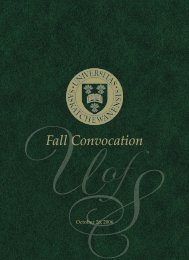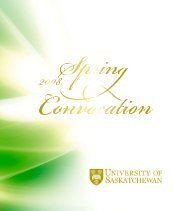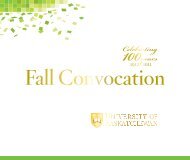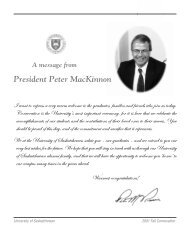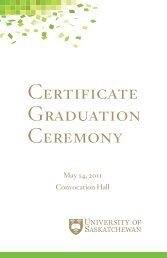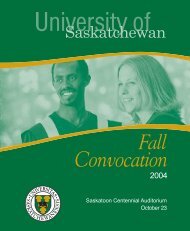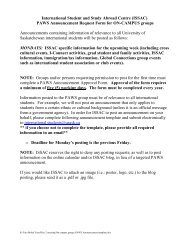Spring Convocation - Students - University of Saskatchewan
Spring Convocation - Students - University of Saskatchewan
Spring Convocation - Students - University of Saskatchewan
Create successful ePaper yourself
Turn your PDF publications into a flip-book with our unique Google optimized e-Paper software.
Walter C. Murray First U <strong>of</strong> S President – 1908-1937<br />
Following are excperts from a speech<br />
delivered in 1946 by Grant MacEwan,<br />
former Pr<strong>of</strong>essor <strong>of</strong> Animal Husbandry at<br />
the U <strong>of</strong> S:<br />
“I don’t suppose anybody left a more vivid<br />
mark upon the youthful face <strong>of</strong> Western<br />
Canada than the late Walter C. Murray.<br />
It wasn’t just what he did but it was the<br />
“Murray way” he had <strong>of</strong> doing it that<br />
made him loved. He distinguished himself<br />
as a philosopher and he was a great<br />
educator; yes, but more than that, he was<br />
distinguished for his tremendous capacity<br />
for friendship; he was a great Canadian.<br />
Walter Charles Murray was born at<br />
Studholm in King’ s County, New<br />
Brunswick, on May 12, 1866. From the<br />
local schools, young Murray went to the<br />
<strong>University</strong> <strong>of</strong> New Brunswick and graduated<br />
in 1886, a distinguished gold medalist. He<br />
was awarded a scholarship which permitted<br />
him to pursue graduate studies overseas and<br />
he elected philosophy at the <strong>University</strong> <strong>of</strong><br />
Edinburgh. Leaving Edinburgh he travelled<br />
in Europe and studied in Berlin and then<br />
returned to become Pr<strong>of</strong>essor <strong>of</strong> Philosophy<br />
at his own <strong>University</strong> <strong>of</strong> New Brunswick.<br />
Dalhousie <strong>University</strong> wanted him and got<br />
him in 1892, and there he remained until<br />
1908 when he accepted the challenge <strong>of</strong><br />
the new North West.<br />
Murray had a vision <strong>of</strong> a provincial<br />
<strong>University</strong> dedicated to service, a vision<br />
<strong>of</strong> a peoples’ <strong>University</strong>. It was to be the<br />
servant <strong>of</strong> an agricultural area, conducting<br />
useful research, and turning out able<br />
leaders; and raising cultural standards.<br />
Dr. Murray’s relationship to his students was<br />
Walter Murray in his <strong>of</strong>fice, 1937. A-5537<br />
extremely happy. He got along well with<br />
them. He could call most <strong>of</strong> them by name<br />
and actually he knew a great deal about the<br />
problems confronting them individually.<br />
No one enjoyed good humor more than<br />
Murray and there was no lack <strong>of</strong> originality<br />
in his own. The first two dormitories<br />
on his campus, <strong>Saskatchewan</strong> Hall and<br />
Qu’Appelle Hall, were called after two<br />
rivers in the province. He threatened to<br />
call the next one Carrot Hall. It was his<br />
observation that “the modern pastime<br />
known as necking had done more to<br />
discourage the habit <strong>of</strong> tobacco chewing<br />
than a thousand years <strong>of</strong> reform.”<br />
In training, Walter Murray was a<br />
philosopher but all through the years,<br />
nothing gave him greater satisfaction than<br />
his associations with agriculture. In the<br />
formative years, he conferred with Dean<br />
Rutherford in the planning <strong>of</strong> the <strong>University</strong><br />
barns and the laying out <strong>of</strong> the fields. And<br />
he watched the horses and cattle and sheep,<br />
and pigs. He loved the growing things; he<br />
enjoyed nothing more than to stroll through<br />
the barns and talk to the horses.<br />
And while he had that great interest in<br />
animals, he had a great and sympathetic<br />
love for people. If there was a Santa Claus in<br />
Saskatoon, his other name was Murray, and<br />
in those years <strong>of</strong> depression, no one will<br />
ever know how much aid and assistance he<br />
gave, and nearly always anonymously.<br />
When Walter Murray died on March 23,<br />
1945, age 79, men and women in all<br />
provinces and in all walks <strong>of</strong> life, mourned<br />
his going. They mourned the passing <strong>of</strong> one<br />
<strong>of</strong> God’s gentlemen, a noble Canadian, a<br />
man who loved his fellows and lived to<br />
make Canada a better place.”<br />
– J.E. Murray fonds, file B.I.3<br />
<strong>University</strong> <strong>of</strong> <strong>Saskatchewan</strong> 35 <strong>Spring</strong> <strong>Convocation</strong> 2007



